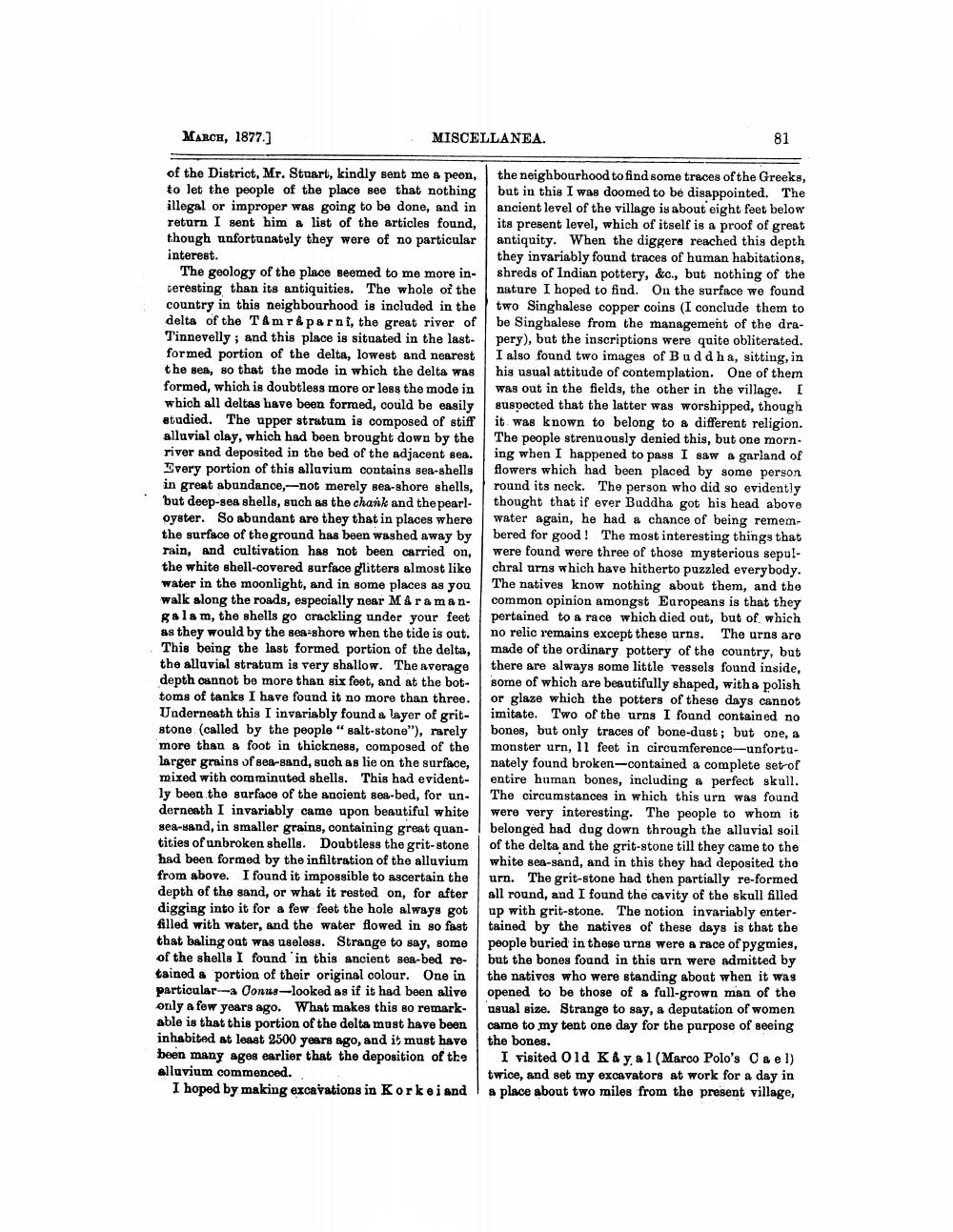________________
MARCH, 1877.]
MISCELLANEA.
81
of the District, Mr. Stuart, kindly sent me a peon, the neighbourhood to find some traces of the Greeks, to let the people of the place see that nothing but in this I was doomed to be disappointed. The illegal or improper was going to be done, and in ancient level of the village is about eight feet below return I sent him a list of the articles found, its present level, which of itself is a proof of great though unfortunately they were of no particular antiquity. When the diggers reached this depth interest.
they invariably found traces of human habitations, The geology of the place seemed to me more in- shreds of Indian pottery, &c., but nothing of the teresting than its antiquities. The whole of the nature I hoped to find. On the surface we found country in this neighbourhood is included in the two Singhalese copper coins (I conclude them to delta of the Tamr& parni, the great river of be Singhalese from the management of the draTinnevelly; and this place is situated in the last- pery), but the inscriptions were quite obliterated. formed portion of the delta, lowest and nearest I also found two images of Buddha, sitting, in the sea, so that the mode in which the delta was his usual attitude of contemplation. One of them formed, which is doubtless more or less the mode in was out in the fields, the other in the village. I which all deltas have been formed, could be easily | suspected that the latter was worshipped, though studied. The upper stratum is composed of stiff it was known to belong to a different religion. alluvial clay, which had been brought down by the The people strenuously denied this, but one morn. river and deposited in the bed of the adjacent sea. ing when I happened to pass I saw a garland of Every portion of this allavium contains sea-shells flowers which had been placed by some person in great abundance, not merely sea-shore shells, round its neck. The person who did so evidently but deep-sea shells, such as the chank and the pearl. thought that if ever Buddha got his head above Oyster. So abundant are they that in places where water again, he had a chance of being rememthe surface of the ground has been washed away by bered for good! The most interesting things that rain, and cultivation has not been carried on, were found were three of those mysterious sepulthe white shell-covered surface glitters almost like chral urns which have hitherto puzzled everybody. water in the moonlight, and in some places as you The natives know nothing about them, and the walk along the roads, especially near Maraman- common opinion amongst Europeans is that they galam, the shells go crackling under your feet pertained to a race which died out, but of which as they would by the sea-shore when the tide is out. no relic remains except these urns. The urns are
This being the last formed portion of the delta, made of the ordinary pottery of the country, but the alluvial stratum is very shallow. The average there are always some little vessels found inside, depth cannot be more than six feet, and at the bot. some of which are beautifully shaped, with a polish toms of tanks I have found it no more than three. or glaze which the potters of these days cannot Underneath this I invariably found a layer of grit- imitate. Two of the urns I found contained no stone (called by the people" salt-stone"), rarely bones, but only traces of bone-dust; but one, a more than a foot in thickness, composed of the monster urn, 11 feet in circumference-unfortularger grains of sex-sand, such as lie on the surface, nately found broken--contained a complete set of mixed with comminuted shells. This had evident- entire human bones, including a perfect skull. ly been the surface of the ancient sea-bed, for un- The circumstances in which this urn was found derneath I invariably came upon beautiful white were very interesting. The people to whom it sea-sand, in smaller grains, containing great quan- belonged had dug down through the alluvial soil tities of unbroken shells. Doubtless the grit stone of the delta and the grit-stone till they came to the had been formed by the infiltration of the alluvium white sea-sand, and in this they had deposited the from above. I found it impossible to ascertain the urn. The grit-stone had then partially re-formed depth of the sand, or what it rested on, for after all round, and I found the cavity of the skull filled digging into it for a few feet the hole always got up with grit-stone. The notion invariably enterfilled with water, and the water flowed in so fast tained by the natives of these days is that the that baling out was useless. Strange to say, some people buried in these urns were a race of pygmies, of the shells I found in this ancient sea-bed re- but the bones found in this urn were admitted by tained a portion of their original colour. One in the nativos who were standing about when it was particular--a Conus-looked as if it had been alive opened to be those of a full-grown man of the only a few years ago. What makes this so remark- usual size. Strange to say, a deputation of women able is that this portion of the delta must have been came to my tent one day for the purpose of seeing inhabited at least 2500 years ago, and it must have the bones. been many ages earlier that the deposition of the I visited Old K& y al (Marco Polo's Cael) alluvium commenced.
twice, and set my excavators at work for a day in I hoped by making excavations in Korke i and a place about two miles from the present village,




